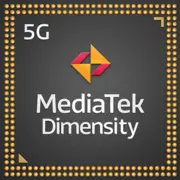MediaTek Dimensity 800U

MediaTek Dimensity 800U: a Balance of Performance and Affordability in 2025
April 2025
Introduction
In the world of mobile technology, the choice of processor often determines how fast a smartphone will be, its energy efficiency, and its readiness for future updates. The MediaTek Dimensity 800U, released back in 2020, remains popular in the budget and mid-range segments by 2025. Despite the emergence of newer chips, its relevance is sustained through software optimization and the affordable pricing of devices. Let’s explore who this processor is suitable for and what advantages it offers.
1. Architecture and Technology Process: the Foundation of Stability
Cores and Frequencies
The Dimensity 800U is built on a hybrid Big.LITTLE architecture with 8 cores:
- 2× Cortex-A76 with a frequency of up to 2.4 GHz for resource-intensive tasks.
- 6× Cortex-A55 with a frequency of 2.0 GHz for background processes.
This division ensures a balance between performance and energy saving. For example, when launching a game, the powerful A76 cores are engaged, while for social media or music, the energy-efficient A55 cores are utilized.
Mali-G57 MP3 GPU
The Mali-G57 MP3 graphics accelerator with three compute units supports Vulkan 1.1 and OpenGL ES 3.2 APIs. It is capable of processing HDR graphics and dynamic shading, which is important for modern games and videos.
7-nanometer Technology Process
Although by 2025, 5-nanometer and 4-nanometer chips have become the norm, the 7-nanometer technology of the Dimensity 800U remains effective. It minimizes heat and maintains stable operation even under prolonged load.
2. Performance in Real Tasks: What Can the Dimensity 800U Do?
Gaming
- Medium settings in AAA titles: Genshin Impact or Call of Duty: Mobile can be launched at medium settings with a frame rate of 30-40 FPS. In less demanding games (e.g., Mobile Legends), stable 60 FPS is achievable.
- 90 Hz support: On smartphones with 90 Hz displays, the processor handles smooth animations, but in gaming, this requires lowering graphical presets.
Multimedia
- 4K@30fps: Recording and playing 4K video without lags.
- HDR10+: Support for high dynamic range in streaming services (Netflix, YouTube).
AI Applications
The built-in AI processor (APU 3.0) accelerates:
- Photography: Automatic scene adjustment, noise reduction in Night Mode.
- Voice Assistants: Quick processing of requests even in background mode.
Power Consumption and Heating
With a TDP of 10 watts, the chip remains cool in everyday scenarios. In gaming, temperatures reach 40-42°C, but throttling (frequency reduction) only begins after 15-20 minutes of intensive use. Smartphones with liquid cooling (e.g., Realme 8 Pro) show better stability.
3. Integrated Modules: Future Connectivity in the Past
5G Modem
- Sub-6 GHz: Support for 5G networks provides speeds of up to 2.3 Gbps, but by 2025, this is no longer sufficient for mmWave scenarios (e.g., AR streaming).
- Dual SIM 5G: The simultaneous operation of two 5G cards is an advantage for travelers.
Wi-Fi and Bluetooth
- Wi-Fi 5 (802.11ac): Maximum speed of 1.3 Gbps. The lack of Wi-Fi 6E limits use in high-load networks.
- Bluetooth 5.1: Stable connection for wireless headphones, but no support for LE Audio for ultra-low energy consumption.
Navigation
Support for GPS, GLONASS, Galileo, and QZSS provides accuracy within 3 meters, which is sufficient for maps and taxi services.
4. Comparison with Competitors: Where Does Dimensity 800U Stand?
Snapdragon 778G (2021)
- Pros of Snapdragon: The Adreno 642L GPU is 15-20% more powerful than the Mali-G57, with better optimization for gaming.
- Cons: Higher smartphone prices ($350 in 2025 vs. $250-300 for the Dimensity).
Exynos 1080 (2020)
- Pros of Exynos: The 5-nanometer technology and Mali-G78 GPU provide an advantage in energy efficiency.
- Cons: Lack of 5G Dual SIM support.
Kirin 820 (2020)
- Similar performance, but issues with availability due to sanctions against Huawei.
Conclusion: The Dimensity 800U lags behind newer chips from 2023-2024 (e.g., Dimensity 9200) in AI tasks and gaming, but prevails in price.
5. Usage Scenarios: Who Is the Processor Designed For?
Gaming
Suitable for casual gamers. It is recommended to choose models with 8 GB of RAM and a cooling system (Xiaomi Poco X4 Pro).
Everyday Tasks
- Smooth operation with browsers, office applications, and streaming.
- Multitasking: the simultaneous launch of 10-12 applications without lags.
Photo and Video
- Cameras up to 64 MP: The chip processes shots with noise reduction and HDR, but it lacks the power for 108 MP sensors.
- 4K video: Stable recording, but electronic stabilization sometimes “cuts” the frame.
6. Pros and Cons: Is It Worth Choosing?
Pros:
- Optimal device pricing ($250-$400).
- Support for 5G and Dual SIM.
- Good battery life (up to 8-10 hours of screen use).
Cons:
- The Mali-G57 MP3 is weaker than competitors in gaming.
- Lacks Wi-Fi 6E and Bluetooth 5.3.
- Limited support for ultra-high resolution cameras.
7. Practical Tips: How to Choose a Smartphone with Dimensity 800U?
- Cooling: Look for models with copper tubes or graphene plates.
- RAM: At least 6 GB (preferably 8 GB for gaming).
- Display: AMOLED with 90 Hz for comfortable use.
- Examples of 2025 models: Realme 10, Xiaomi Redmi Note 13, Motorola Moto G Stylus (2025).
8. Final Conclusion: Who Is the Dimensity 800U Suitable For?
This processor is a choice for those who:
- Do not want to overpay for flagships but value a smooth interface.
- Game occasionally, preferring medium graphics settings.
- Need 5G without a budget for top devices.
Key Benefits: The balance of price, battery life, and sufficient power for most tasks. By 2025, the Dimensity 800U remains a “workhorse” in the budget segment, proving that even five-year-old technology can still be relevant.
Note: The prices mentioned are accurate as of April 2025 for new devices in the USA.
Basic
6x 2 GHz – Cortex-A55
GPU Specifications
Connectivity
Memory Specifications
Miscellaneous
Benchmarks
Phones with Dimensity 800U





Comparison of Devices with Dimensity 800U
Compared to Other SoC
Share in social media
Or Link To Us
<a href="https://cputronic.com/en/soc/mediatek-dimensity-800u" target="_blank">MediaTek Dimensity 800U</a>